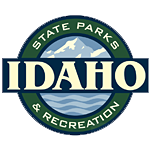The 995.6-mile Idaho Centennial Trail (ICT) weaves through the most scenic portions of Idaho’s wild country, from high desert canyonlands in southern Idaho to wet mountain forests in North Idaho.
Designated the official state trail during Idaho’s Centennial year in 1990, the southern portion of the trail begins at 6,000 feet near Murphy Hot Springs on the Idaho/Nevada border. Heading north, the trail descends to 2,500 feet at the Snake River near Glenns Ferry. The trail yo-yos up and down through the mountains of Central Idaho between 3,000 and 9,000 feet. At its low point (1,900 feet above sea level) the trail skirts the Selway River near the Moose Creek Guard Station then climbs again to high points up to 6,000 feet in the Cabinet and Selkirk Mountains as the trail approaches the northern boundary.
The ICT crosses three historic trails along its route: the Oregon Trail near the Snake River, the Lewis and Clark Trail (on the north ridge above the Lochsa River) and the alternative route crosses the Nez Perce Trail. Those who travel the entire length of the trail will cross through 11 national forests and about 100 miles of Bureau of Land Management land in the high desert.
Three wilderness areas can be explored on the trail: the Sawtooth Wilderness, the Frank Church-River of No Return Wilderness and the Selway-Bitterroot Wilderness for a distance of more 300 miles. The trail also courses along the famed Middle Fork of the Salmon River (if you like to fish, you’ve got to bring your fishing pole) and the Selway, both of which were among the original eight National Wild and Scenic Rivers because of their purity, beauty and wild character (no dams from source to mouth). North of the Selway-Bitterroot, the trail hop-scotches along the Idaho-Montana border on the backbone of the Bitterroot Mountains for more than 85 miles on high ridges. Dozens of high mountain lakes along this portion of the route will beckon the hard-core angler. There is also an alternative route available that skirts the wilderness areas.
The Idaho Centennial Trail passes through some of Idaho’s most spectacular country. The route traverses a variety of terrain including sagebrush desert, flower-filled alpine meadows, dense cedar forests, six major river canyons and numerous crystal clear mountain takes. Many unique geological formations, such as caves and hot springs, can also be seen from the trail. Along the way you will find Idaho as it was 100 years ago. Abandoned homesteads and cabins, old mines, logging camps and a restored, old time ranger station are many of the interesting sites along the route.
The Centennial Trail primarily crosses public land, but there are small segments of private land along the way. Permission to cross or camp on private land must be obtained from the land owner. The trail is cooperatively managed by the Idaho Department of Parks and Recreation, which provides overall trail coordination; the Bureau of Land Management, which manages of southern section of trail; and the U. S. Forest Service, which manages the middle and northern sections of the trail and private and other public land agencies allow trail users to cross their property for continuity.
More Information
- To learn more about the Idaho Centennial Trail, check out The Hiker’s Guide: Idaho Centennial Trail by Lisa and Jeremy Johnson. It is the most comprehensive resource for anyone interested in exploring the trail.
- View an interactive topographical map
- View a downloadable trail overview map that includes contact information for US Forest Service and BLM offices along the way
- Download .zip file with GPS coordinates
- Download a .pdf with detailed information about the trail (signage, wildlife, access issues, re-supply points, history and more)
- Idaho Centennial Trail blog with lots of information including updates from current ICT hikers
- Idaho Public Television piece about the Centennial Trail
For more information, contact inquiry@idpr.idaho.gov


